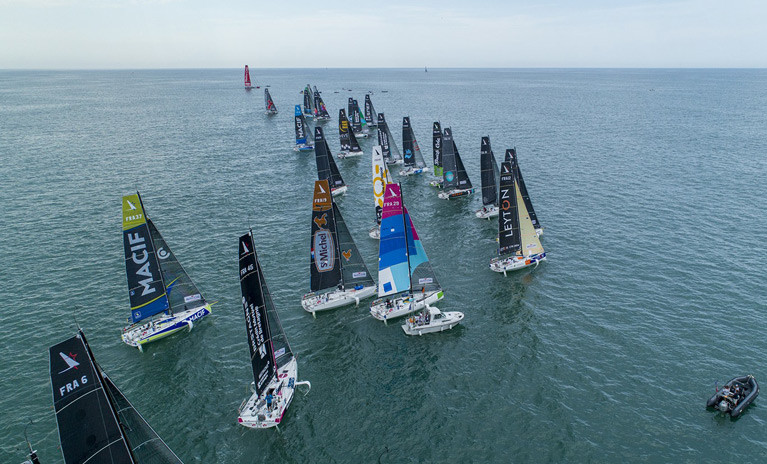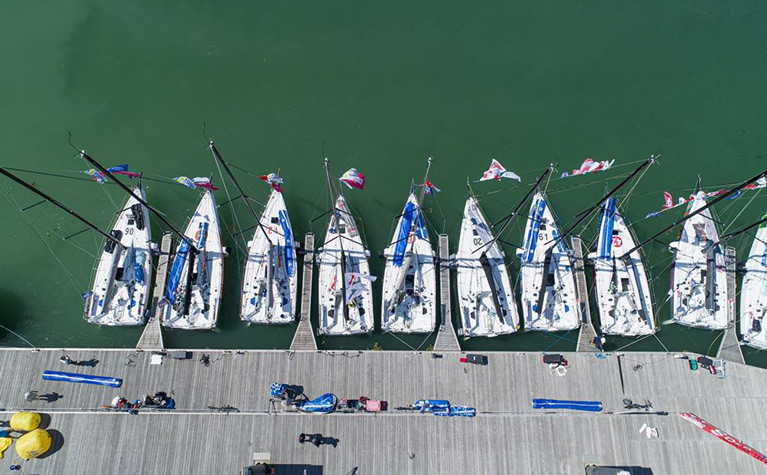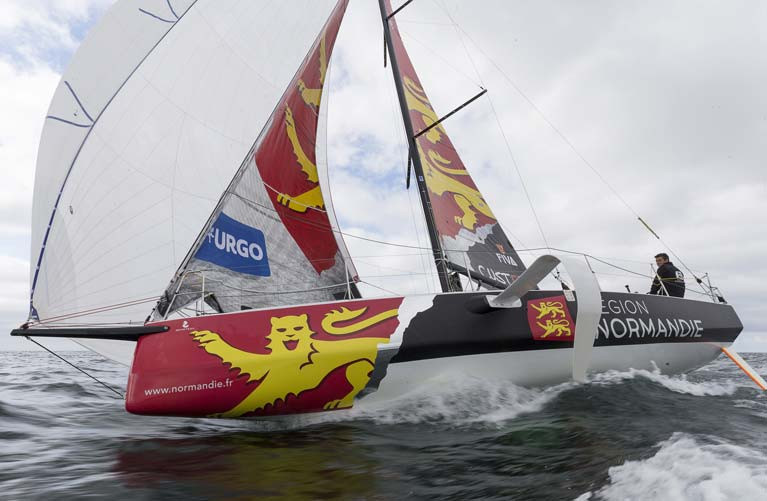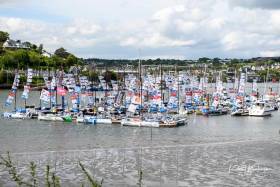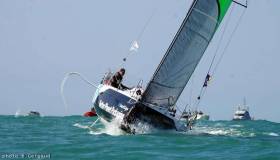Displaying items by tag: Figaro
Irish 'Figaristes' Have It All to Play for After First Night of Solo Maitre Coq (Tracker Here!)
It's been a baptism of fire for both Irish competitors in the 2020 Solo Maitre CoQ after the first night at sea in light and tricky conditions.
Both Dublin's Kenny Rumball and Meath's Tom Dolan are currently in the bottom third of the 30-boat fleet but as anyone knows in offshore racing, with 300 miles still to sail, anything can happen before this weekend's finish. See Tracker below.
The start of the 17th edition began yesterday (Thursday) at 1:15 pm, off Sables d'Olonne.
 Dun Laoghaire's Kenny Rumball (centre) on starboard tack shortly after the start
Dun Laoghaire's Kenny Rumball (centre) on starboard tack shortly after the start
The 30 sailors in the running then set off on a 340-mile course between Belle-Ile, Yeu and Ré, propelled by a northwest wind blowing between 5 and 6 knots. It was a breeze that quickly died out and almost completely died away on the approach to the rescue buoy, literally breaking up the fleet.
 Meath's Tom Dolan (Smurfit Kappa on mainsail) at the first turning mark
Meath's Tom Dolan (Smurfit Kappa on mainsail) at the first turning mark
Well in tune in these erratic conditions, top-ranked Armel Le Cléac’h (Banque Populaire) was the first to turn south towards the Ile de Ré.
Overnight the fleet has spread out and leaders are now some ten nautical miles ahead of the rival Irish boats.
These are certainly challenging conditions for the Figaristes, where the challenge today for both Irish boats is to haul themselves back up the leaderboard.
Both Irish sailors are updating to Facebook. Tom Dolan here and Kenny Rumball here
Light Winds for Rumball v Dolan in Today's Solo Maître CoQ Offshore Race (Tracker Here!)
Lunchtime today effectively sees the first Irish battle on the long road to the Paris Olympic Games 2024 as two embryonic campaigns go head to head in the offshore keelboat discipline, in the French season opener, the Solo Maître CoQ.
Both Kenny Rumball and Tom Dolan are embarking on a journey for the single Olympic place in the new mixed offshore keelboat class that will ultimately see them sail double-handed with a female teammate but for now racing this season is on a solo basis, starting today.
Racing over a varied 340-mile course the rival Irish will compete against a high-quality field of competitors, it is an ideal warmup for the main objective of the season: the Solitaire du Figaro from 25 August-20 September.
"We're docked up in Les Sabes D'Olonne, the course is plotted, it's all happening...." declared the rookie Rumball on social media who has completed just a month's training in his new boat on Dublin Bay in June, as Afloat reported here.
The race starts and finishes in the legendary French port of Les Sables d'Olonne and takes the 30 solo skippers up and down the French Atlantic coast in what promise to be light and fickle breezes.
Last year's event comprised two shorter races and one long offshore but this year the race, which has been rescheduled from its original mid-March date, spans the coastline between Belle Ile in the north, level with Nantes, and at the southernmost extremity, the Ile de Ré off La Rochelle of what looks set to be a mainly reaching course.
County Meath solo racer Tom Dolan will also get his 2020 racing season underway.
"It has been a year since I have raced solo but even though I, like everyone else in this sport, have not been able to train on the water much I feel well prepared and itching to go. I spent time during lockdown reading and re-reading the key weather texts and doing on-line courses. I have worked hard on the mental side of my approach as well as doing all I could to bolster my obvious weakness, starting." Dolan explains, "So I feel ready to go. I do believe I have a better, more mature outlook which i hope will serve me well in this second season in the Figaro 3."
At 1300hrs local time Thursday racing starts offshore of the famous town which hosts the Vendée Globe solo round the world race and it should finish Saturday morning or early afternoon.
"It looks like it will be light, tactical sea breezes a lot of the time with some very light spells. To be honest, right now the start time looks very, very light. But I think it will be essential to get away with the first pack and not be left behind if you are to have a good chance."
Dolan is looking for a good race to kick off the truncated season but will not over-pressurise himself. The big goal is to be competitive for September's La Solitaire du Figaro. In essence, this course is very much a Solitaire dress rehearsal in terms of length and duration but the pinnacle event this year is mainly in the Channel, finishing into Saint Nazaire at the entrance to the Loire estuary.
"I have worked on my decision making processes and most particularly minimising how a small mistake can lead to a downwards spiral, making more mistakes because you increase your risks and make rash decisions to try and make your losses back. Far better to stay patient and maintain a solid work rate and wait for others to make mistakes. This game proves the sailors who make the fewest mistakes win," Dolan concludes.
Dolan says he is keen to represent his home nation in the mixed offshore discipline at the 2024 Olympics and is keeping an eye on what other sailors from Ireland and from different countries are doing.
With the gradual easing of the French lockdown and offshore racing sailors now having returned to training, the future is again looking brighter for Irish solo racer Tom Dolan.
Since relaunching at the beginning of June the Brittany based racer, who originates from Kells, County Meath, has been accumulating hours on his Figaro Beneteau Smurfit Kappa and is now making final preparations for what will be the first race of the season, next week’s Solo Maitre Coq which starts and finishes in Les Sables d’Olonne.
“It will be nearly a year since I have raced solo, so yes there is a wee bit of rustiness, but it comes back quickly. It is like riding a bike in some ways, you don’t lose it, but you’re looking for the finesse to return, making manoeuvres smooth and instinctive, especially looking towards working on a dark night when you can’t afford mistakes.” Dolan asserts, “But for sure I can’t wait to be back out racing. It has been much too long.”
Tuesday day and overnight this week, Dolan is making a 24 hour offshore training sortie with the Lorient Grand Large group of which he has been a long time member. Until now he has just had four or five days training locally himself as well as some important corporate sailing with guests from Concarneau who were due to support him and co-skipper François Jambou with whom he was due to race the AG2R Transatlantic in April which was postponed until 2021. The duo also took key workers who were on the front line during the worst of the Covid-19 crisis out for a sail.
“Immediately the objective is to have the boat ready to pass the safety and measurement checks. There are still some water ingress issues which other boats still also have. The builders are working on it but it is not an ideal situation as we approach the second season with these boats.” Dolan comments.
With doubt surrounding the running of this year’s La Solitaire du Figaro for many months, the news that it will go ahead in September is a considerable relief for Dolan and all of the Figaro sailors.
“For a while, it was looking pretty grim, as if there might not be any racing at all this season. To their credit, Smurfit Kappa have been very supportive. They have been stretched through the crisis supplying packaging for essential supplies. They completely understood the situation.” Dolan concludes.
The Solo Maitre Coq race starts Thursday next week and should finish Saturday.
Kenny Rumball & Pam Lee's Double-Handed Offshore Sailing Campaign Arrives into Dun Laoghaire
As I type this, I am currently motor sailing along the Brittany coast having left Port La Floret and am delivering Figaro3 Number 20 to Dun Laoghaire with my co-skipper Pamela Lee.
There has been a lot of speculation in both the media and also amongst the sailing community regarding the inaugural Double Handed Offshore Worlds that were due to be held in Malta in October 2020. This is my story and my views on the handling of the event and the challenges that have had to be overcome if anybody wants to compete at this level. It also our plans for the future for double-handed offshore sailing.
As early as 2017, World Sailing announced there would be a potential new discipline for the Olympic Games of a mixed crew double-handed offshore style discipline. Sailing and sport is constantly evolving with commercial pressures such as sponsorship and TV rights having an influential effect on the style and format of sailing events. There has been talk of this new discipline involving constant live streaming of cameras onboard the boats with drama and images fed ashore continually. This concept was turned to reality with the proposal of the inaugural Double Handed Offshore Worlds that were/are due to be held in Malta in October. There were/are 20 international teams due to take part in this event. One team per country. Irish Sailing representing Ireland was one of the countries that applied for one of the spots for this event. This occurred in November 2019.
 Kenny onboard the new Beneteau Figaro 3
Kenny onboard the new Beneteau Figaro 3
There next came the challenge as to how to select the best Irish team to represent Ireland at this event. There has been some speculation as to how effectively Irish Sailing promoted this opportunity to the sailors of Ireland. In my own personal view, I believe that anybody looking for this information could have easily found it. There were no hidden secrets or emails sent to selective potential representatives, teams were invited to submit expressions of interest to Irish Sailing. Myself and Joan Mulloy were one of a small number of teams who sent in an expression of interest to Irish Sailing. We did this in December 2019.
Irish Selection
Irish Sailing then needed to find a way to select the best team to represent Ireland. It is my belief that Irish Sailing enlisted the services of Marcus Hutchinson who has for many years managed IMOCA teams and is heavily involved in the Figaro 3 class and organisation in France. The Figaro class and race calendar of single-handed & double-handed events is arguably the pinnacle of short-handed small boat offshore sailing in the world. Marcus and Irish Sailing proposed a three-race series of two races for Irish teams only with course lengths of 50 and 100 miles and then the Solo Concarneau race due to be held in April 2020. There were questions as to this selection process including; Why France?; Why Figaro 3s; Why a race that is part of the Figaro circuit? Other questions stemmed from these including costs, Figaro 3 boat time & experience. The simple answer is that if Ireland wants to have the best possible representation at these world championships the Figaro race circuit is the best proving ground available. For me personally, if you want anything in life, you will find a way to make it happen. This you will see is a running theme, there have been a lot of unforeseen obstacles that have had to be tackled and overcome to get this far.
"The simple answer is that if Ireland wants to have the best possible representation at these world championships the Figaro race circuit is the best proving ground available"
The first of which was Joan’s fantastic news which is far more important than any sailing campaign. Joan was pregnant and as a result, would not be able to realistically compete in either the qualifying events or the event in Malta. Therefore I approached Pam, who had only recently returned to Ireland after eight years abroad offshore racing and professional crewing on superyachts and race campaigns in Australia, UK, the Mediterranean and the Caribbean, to join the team. Pam subsequently forfeited and rearranged her existing personal and professional plans to get onboard for making this campaign a reality.
Figaro3 learning curve
We then needed to get sailing, Joan had worked with Marcus previously in her earlier Figaro sailing so between Joan, Pam and myself with input for chartering a boat and logistics advice from Marcus, we went to France with Joan acting as a coach and Pam and I learning how to sail a Figaro3, this was a month before the original Irish Sailing qualification process in early March. We had a great week and learnt a lot but it became clear how much more we really needed to learn if we were to seriously compete not just to win the qualifiers to represent Ireland but to represent Ireland at the Offshore World Championships in Malta.
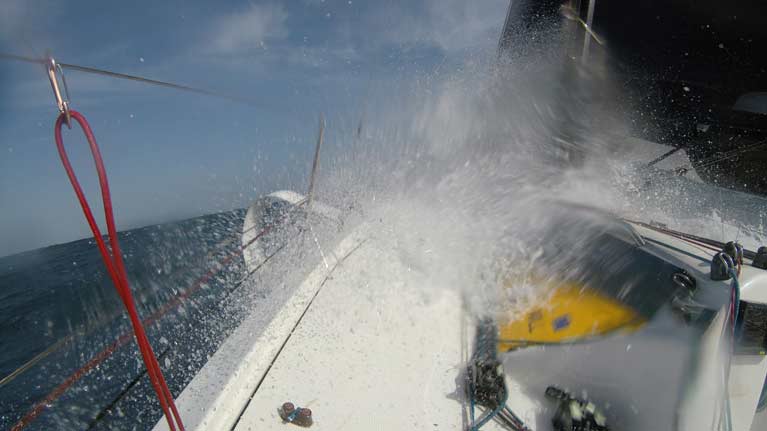
Covid-19
Unfortunately, as we were leaving France, the Covid-19 pandemic was just starting to unfold… Yet another challenge to overcome and also a lot of uncertainty as we all now know. Despite the uncertainty, the end goal was also at the forefront of our minds as to represent Ireland in Malta in October. To accomplish this we had agreed as a team then as soon as the various lockdowns around the world were lifting or showing signs of lifting, we were straight out to France to put the boat back in the water and get sailing. Our plan included getting the boat to Ireland as soon as possible. This was because it had been hinted that the Round Ireland yacht race may be used as the qualifying event for Malta. So on Thursday the 14th of May, with various letters and my father Alistair to help with transport logistics, I was on a ferry from Rosslare to Cherbourg to get to the boat, Pam armed with similar letters was flying on one of the five scheduled flights in total the next day out of Dublin airport.
Plan B - La Solitaire du Figaro
As a team, we had discussed the possibilities and probabilities of the event in October actually occurring and naturally had come up with a plan B. A simple plan but one that would give the team more overall experience of short-handed offshore racing in the Figaro class. The backup was for me to do the solo Figaro circuit including the Solitaire du Figaro to learn the boat and also improve short-handed offshore sailing techniques. Reality quickly came into play three days ago when we were leaving France on the 20th May that plan B would have to be put into place as World Sailing cancelled its World Offshore Championships for 2020.
Sailing home to Dun Laoghaire
 (Above and below) Kenny and Pam arrive back into Dun Laoghaire Harbour Photo: Afloat
(Above and below) Kenny and Pam arrive back into Dun Laoghaire Harbour Photo: Afloat
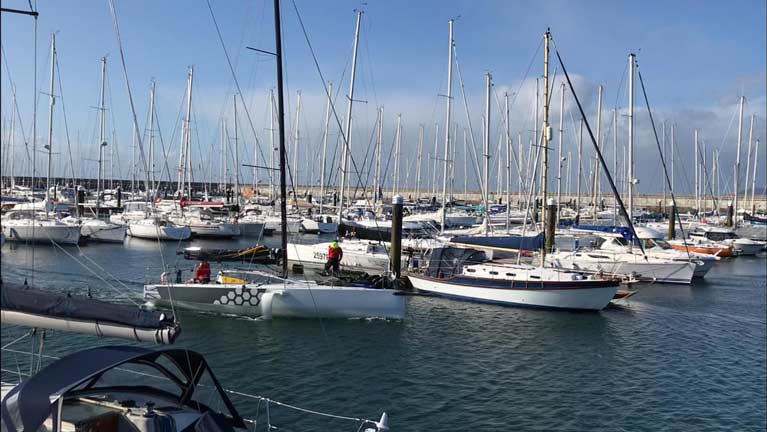
Complying with all the social distancing guidelines in both France and Ireland, we got the boat back to Ireland yesterday evening on the 22nd of May after a two day 317nm spin from Port La Floret. The plan is to train here from Dun Laoghaire Harbour gaining boat handling skills for the next 5 weeks before returning to France for the newly revised Figaro calendar that will include events such as the Drheam Cup, Solo Concarneau, La Solitaire du Figaro and Spi Ouest (Double-Handed). This should hopefully give us a firm grounding in the boats and discipline of sailing ahead of a double-handed season next year and seeking to qualify to represent Ireland at the rescheduled double-handed offshore worlds, hinted to be in Malta in 2021.
You can follow all our races and adventures for the year ahead on https://www.rlsailingteam.com/ Facebook https://www.facebook.com/RLSAILINGTEAM Instagram https://www.instagram.com/rlsailing/
Figaro Bénéteau Class Get Start at Drheam Cup 2020
The third edition of the Drheam Cup, from 18 to 27 July, starting in Cherbourg-en-Cotentin and finishing in La Trinité-sur-Mer, has been opened up to more competitors, as the Open De France De Course au Large-labelled race will welcome a Figaro Bénéteau 3 fleet. It is an opportunity for the solo sailing experts to warm up on the Drheam Cup 400 course, one month before the start of the Solitaire du Figaro.
As Afloat reported previously, due to the COVID-19 pandemic, many organisers are having to postpone or cancel races, including the Solo Maître CoQ, the Solo Guy Cotten and the Transat AG2R, the last three races in the Figaro Bénéteau class season. This had implications for the first Irish selection trial for three trialists vying for the single berth at this year's mixed offshore world championships.
When he launched the Drheam Cup in 2016, its founder Jacques Civilise dreamt of an Open race, taking place in the summer, open to all boats, formats and sailors, enabling everyone to enjoy a real high-level competition in a sharing and celebratory atmosphere. This openness, which led to it being awarded the Open De France De Course label, allowed the two first editions to welcome a multi-class fleet, from Ultimes to Classic Yachts, including Imocas, Class40, Multi50, Multi 2000, IRC, Osiris and Mini 6.50 boats.
In the run-up to the third edition, this quest for openness continues, since the Figaro Bénéteau class has accepted the organiser's invitation to include the Drheam Cup in its official 2020 calendar. "When Jacques Civilise told me that he wanted to welcome Figaro skippers, I immediately loved the idea and I submitted it to the board members, who agreed, explains Yvon Breton, Chairman of the Figaro Bénéteau class. First, because it takes place at an ideal time for the Solitaire du Figaro, which starts just over a month later, and because participating in a multi-class race is an opportunity for our class to open up. This challenge can encourage other participating sailors to join us, we always aim to grow. Finally, it is important for our partners, as the Drheam Cup is well-covered by the media, offering them more visibility.”
Cherbourg skipper Alexis Loison has jumped on the chance to be the first Figaro sailor to enter. "I just had to take part in a race that starts in my home town and has the backing of my sponsor, Région Normandie. The timing is perfect as well, five weeks before the start of the Solitaire du Figaro, it isn't too early or too late, and the Drheam Cup 400 course could be a leg of the Figaro. For us it is a good rehearsal, a warm-up that will enable us to make sure everything is working onboard.”
Bay of Saint-Brieuc To Host Start Of 51st Figaro In 2020
The Bay of Saint-Brieuc in Brittany will host the start of La Solitaire URGO Le Figaro for its 51st edition on 30 August 2020, it has been announced.
As Sail World reports, the schedule for next year’s Figaro was moved forward to August and September in line with the season’s event schedule that’s making room for the Olympic Games in Tokyo from July to early August.
The offshore challenge returns to the Côtes d’Armor for the race start after what OC Sport Pen Duick president Hervé Favre described as an “excellent” stopover in the 2018 edition.
It’s been revealed that the race village in Saint-Quay-Portrieux will open to the public from 26 August until the race gets under way.
Race organisers OC Sport Pen Duick are also hosting the iconic Transat AG2R La Mondiale in the weeks before the Olympics window, for which a serious pitch is being made for mixed two-handed crews in view of the new offshore sailing event for Paris 2024.
Delighted with the warmth of welcome in Kinsale and the interest shown in La Solitaire URGO Le Figaro and his project Tom Dolan, solo skipper of Smurfit Kappa, put to sea this afternoon on the 545 miles course to Roscoff.
See Bob Bateman's report of the Kinsale Figaro race departure here
A last minute course change did not concern Dolan any more than it did the 44 other solo racers. The decision not to take the La Solitaire racers north to the Isle of Man in potentially difficult 35-40 knots winds which were predicted for Tuesday was only announced at 1130hrs this Sunday morning. Dolan immediately fell in step with his team's new weather and strategy briefings for a stage which will now take the fleet into the English Channel where much more sedate, even light winds are promised.
As he left the dock in Kinsale Dolan smiled, "The stop has been short, intense and with a lot of things to do, seeing old friends and so on, which has been lovely. But it has been so great to be here and be able to be doing something which should gain a bit of interest in the sport in Ireland. It is nice and there has been such enthusiasm in Kinsale it has been lovely."
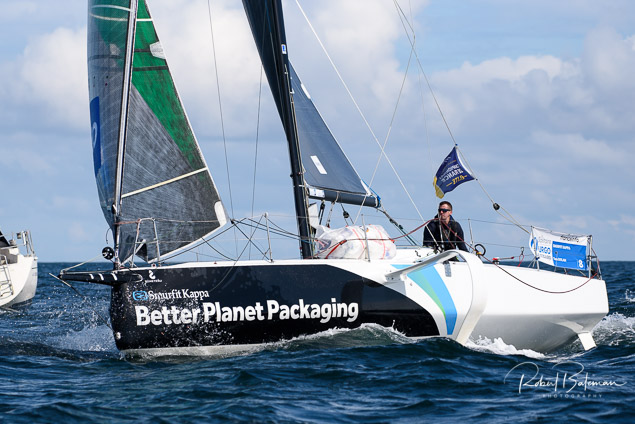
The 530-mile course goes from Kinsale to Bishop Rock at the Scilly Isles then up the Channel to the Needles by the west point of the Isle of Wight before racing back down the Channel to Roscoff. Winds along the southern English coast are set to be light to moderate, dropping for the rounding of The Needles in strong tides.
" This last-minute change is because of the tough weather forecast over the next few days in the Irish Sea. It would have been a bit rock and roll with more than 25 knots of wind, especially in the St. George channel where we also had to deal with the traffic separation schemes, sandbanks, and ferries and that would require us to do more gybes. We know that the seas can get big and messy in the channel in the strong currents. I understand the decision of Race Direction even if all the homework and preparation we have done here in the last two days goes in the bin. We have to start all over again! Dolan adds " And the last 24 hours I had really got into my head the course, thinking about the long upwind and looking forwards to the downwind. But there you have it. You have to adapt, roll with it."
The Irish skipper admits he is as unfamiliar with the Channel as he would have been racing up around the Isle of Man, as planned,
"It will be quite new to me, I do not know the South coast of England that well at all. Now we are expecting a lot of reaching in 10, 12, 13 knots of wind and then we sail into this low-pressure system which is off England, so it could be quite chaotic going across the Channel. I would say it will be one after the other and then at the end it will be light, like the end of the last one, tide, wind all over the place.
I am grand. After the result I got in the first leg I just want to be back out there with the counter set to zero and going again. I took a bit of a kicking on the first leg and so I want to get out and do better."
The second stage started in perfect conditions off Kinsale, 12-13kts of westerly wind and sunshine. Smurfit Kappa was in the middle of the 45 boat fleet as they headed towards Bishop Rock after a characteristic conservative, safe start. Two boats collided on the start line. Alain Gautier, a previous winner, was heading directly to Roscoff with damage to his boat. That's part of the game, however, and it's the same for everyone, "
Forty five solo racers will take the start line on Sunday afternoon at 1700hrs local time, heading out from Kinsale, Ireland on the 615-nautical mile second stage of La Solitaire URGO Le Figaro to Roscoff via the Irish Sea with a turn at the Isle of Man.
Enjoying the Irish stop-over, the sailors were ashore in Kinsale's Market Square where they got a chance to meet the locals as Bob Bateman reported here.
The course comprises four waypoints after the start; Coningbeg off Wexford so the south-east corner of Ireland; Chicken Rock light which is to the south of the Isle of Man; the Isle of Man to starboard and a cardinal buoy, Astan, on the approach to Roscoff and the Morbihan bay.
There is a prologue of about 11 miles, which in essence is the same format as last Sunday’s start from La Baule. From the start out in the Bay, there is a first mark towards Black Head, a second at Bulman which is up the estuary a little, and then to the Radio France buoy which is Daunt Rock, midway to the entrance to Cork Harbour.
The weather for this long leg initially promises more of the same; upwind in light winds, difficult transitions, some thermal influences close to the coast and strong tidal currents on the points, but there seems a good prospect of a fast run back down the Irish Sea at least to the Channel. Going towards the low pressure system(s) in the north will means a strengthening breeze for the leaders, with initial gains magnified by the slingshot downwind. A rich get richer scenario perhaps?
The first stretch up to the Isle of Man is 240 nautical miles. Although the island, famous as a tax haven and for its motor bike TT (which finished yesterday), has featured on stages of the Solitaire du Figaro before, those have always been shortened. So this will be the first time that the race has ever been round the Isle of Man, and in so doing at 54 degrees north, it will be the furthest north that the race has ever been.
But although the leg is the longest of the race, the fleet will be much more constrained, there being no more than 50 or so miles of Irish Sea between Ireland and mainland UK. The tidal coeffiencts are low but the currents are tricky and there many sandbanks on the Irish coast especially which limit the options to go too close in.
The reward for climbing to the Isle of Man should be a fast descent with 25 knots expected during Wednesday night, meaning an express 275 miles downhill ride to Wolf Rock, the first chance for the skippers to really put themselves and the new Figaro Beneeau 3 to the test for such an extended period.
For the start on Sunday, a shallow depression to the north of Ireland will generate a pretty unstable SW’ly flow of around 12knots. Monday into the Irish Sea promises a transition into weak, unstable, variable winds caused at the intersection of two depressions, the one over Ireland moving south and one forming over Central Europe. Tuesday and Wednesday the unstable northerlies should build to be moderate to fresh.
The initial stages of the northwards climb will be contested in unstable breezes, perhaps with some taking an option to gybe further offshore. As the low pressure system moves north, the SW’ly will veer more to the west. A messy, weak front will then bring a shift to the NW. On Monday late morning it will be very light with the risk of calms in a transition area between the two depressions. The question here is which depression will prove the dominant influence and how to position for the future.
Two sailors will not start. The ever popular Gildas Morvan will take no further part on his 22nd La Solitaire. He hit a rock off the Ile de Yeu and suffered structural damage to Niji. He monitored the two cracks all the way to the finish but on inspection by the Beneteau expert in Kinsale, Morvan was advised to retire because the composite repair will take several weeks. He has made a request to the jury to use a replacement boat for the final two stages from Roscoff. The other skipper who will not start is Cassandre Blandin who retired into Brest after hitting a cargo ship.
At the top of the standings after Stage 1 the top three sailors are within four minutes of one another after a leg which lasted four days and three hours for them. Yoann Richomme (Groupe Telegramme-Hellowork) leads rookie Tom Laperche (CMB Bretgane Espoir) by one minute at 13 seconds. The top nine skippers, to Martin Le Pape (Skipper Macif 2017) are within 25 minutes of the leader but then there is a 25 minutes gap to tenth. Of the international competitors, Switzerland’s Justine Mettraux (Teamwork) in 14th is one hour and three minutes behind the leader. Alan Roberts (Seacat Services) is 16th at one hour and 49 minutes behind and Kiwi Conrad Colman (Ethical Power) is two hours and seven seconds behind as well as being third-placed Rookie.
There is a one hour gap between 18th and 19th. Three times winner Yann Eliès (Saint Michel) finds himself in 22nd three hours and 54 minutes off the leader’s time and the delta between Richomme and Jérémie Beyou (Charal) is eight hours and 29 minutes.
Still very much in touch are the likes of past winners Armel Le Cléac’h in 11th at +55 minutes, Michel Desjoyeaux in eighth at +24 mins and sixth placed Loick Peyron at +21 minutes.
On a long stage like this second one, big breakaways are possible and similarly the approaches to Roscoff are never easy. Just as some of these deltas may appear big just now, they can easily close just as much on the second leg.
Recovering from the baptism of fire that was leg one of the 50th La Solitaire URGO Le Figaro race into Kinsale on Thursday, both Irish entrants, Tom Dolan and Joan Mulloy, attended the Skipper's briefing in Kinsale this afternoon as the south coast town greeted the international fleet.
From what is considered the most competitive fleet ever, Yoann Richomme won the opening stage of the 50th La Solitaire URGO Le Figaro. The open, strategic 545-nautical mile leg from Nantes across the Celtic Sea to Kinsale in Ireland proved to be an appropriately testing introduction of the new Figaro Beneteau foil assisted one design yacht.
 Tom Dolan (left) with Joan Mulloy and her sponsor Enda O'Coineen of the Sunday Business Post
Tom Dolan (left) with Joan Mulloy and her sponsor Enda O'Coineen of the Sunday Business Post
Predominantly light and very changeable winds prevailed through the marathon four days and four nights of racing offering very little opportunity to rest. Expected to finish into the picturesque Irish haven on Wednesday, the stage overran by a full 24 hours.
 The Skippers Briefing at Kinsale's White Lady night club
The Skippers Briefing at Kinsale's White Lady night club
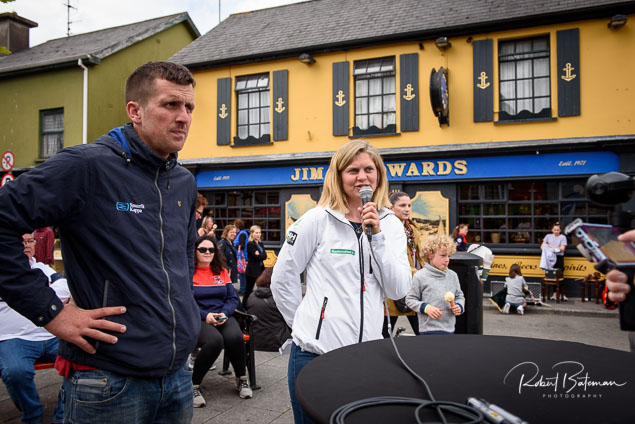 Tom and Joan give their impressions of the first leg at a public reception in Market Square
Tom and Joan give their impressions of the first leg at a public reception in Market Square
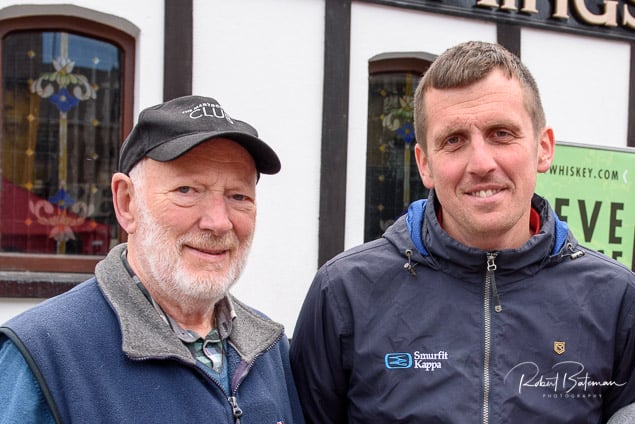 Jim Lyons of RCYC at the Figaro public reception in Kinsale's Market Square
Jim Lyons of RCYC at the Figaro public reception in Kinsale's Market Square
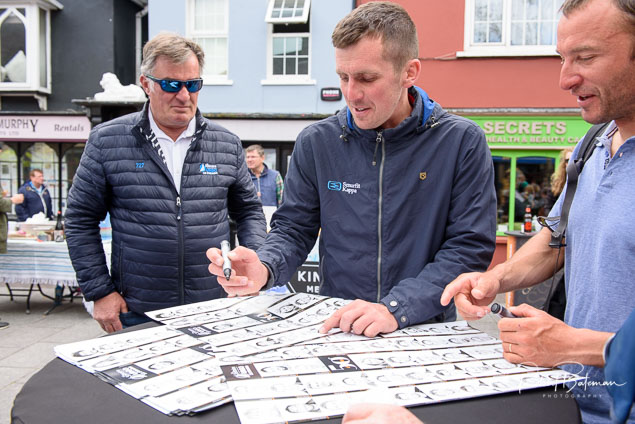
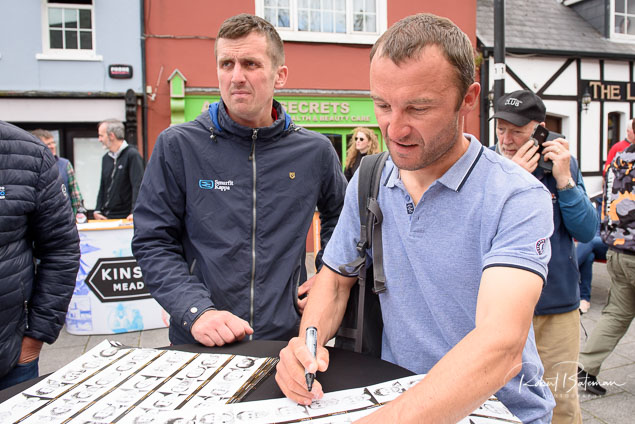 Competitor Adrien Hardy, who is from Nantes is a former French 420 dinghy champion and Mini class racer
Competitor Adrien Hardy, who is from Nantes is a former French 420 dinghy champion and Mini class racer
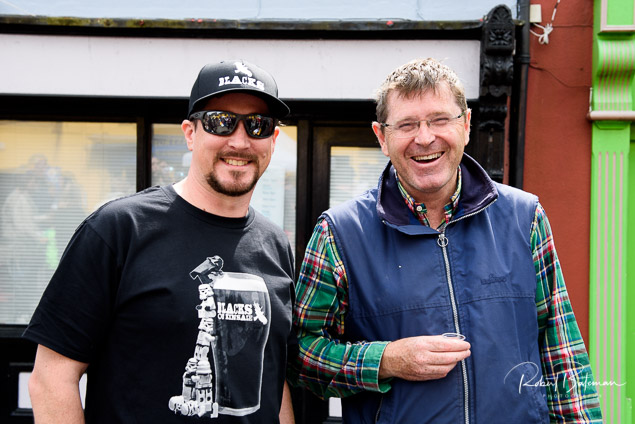 Kinsale Yacht Club Vice Commodore Mike Walsh (right)
Kinsale Yacht Club Vice Commodore Mike Walsh (right)

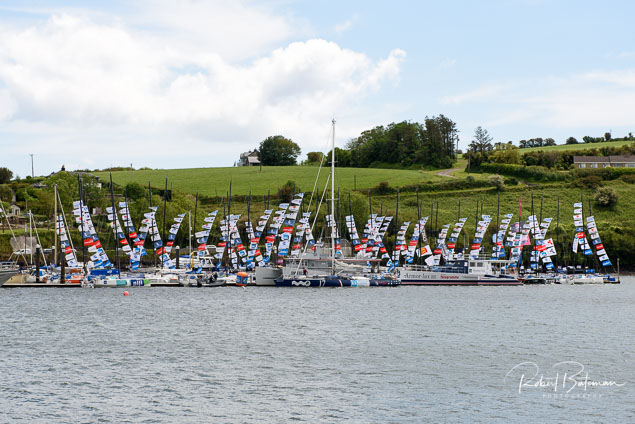
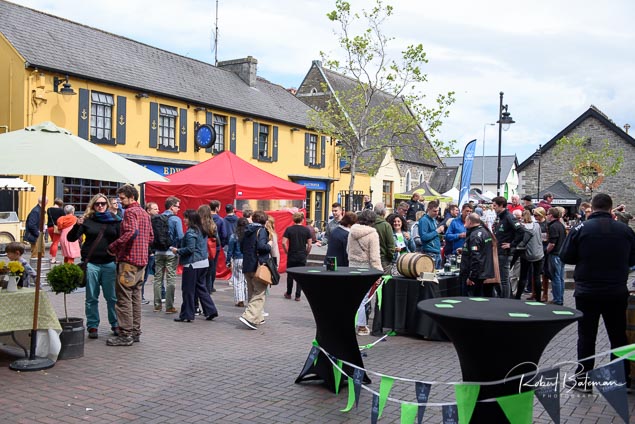
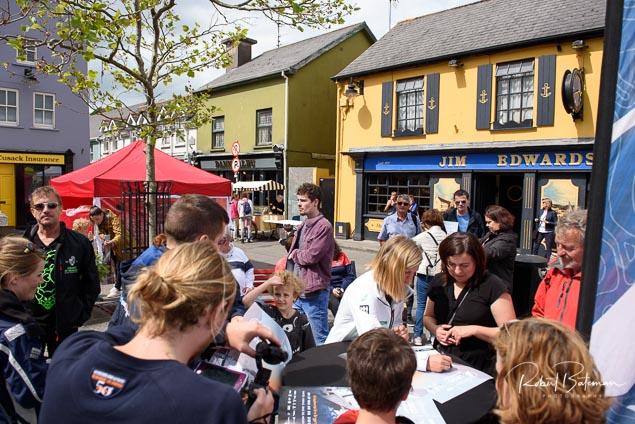
Tom Dolan Moves into Figaro Top Ten in Race to Kinsale
It looks like heading home to Ireland is all the motivation Tom Dolan requires as the County Meath solo sailor has moved up from mid fleet last night to 10th place in the 47-boat La Solitaire du Figaro race fleet this morning.
Dolan and County Mayo sailor Joan Mulloy (currently 39th) are the two Irish sailors competing in the 50th edition of the race that is expected into Kinsale this week, the first port of call in a month long race.
Follow the tracker here. Twitter here. Afloat Figaro Race Irish update channel here


























